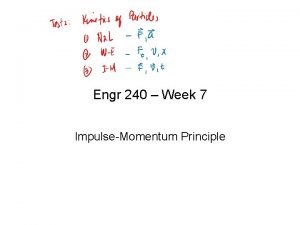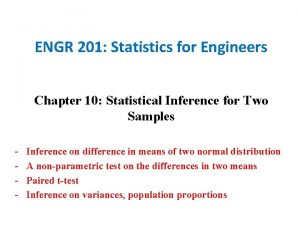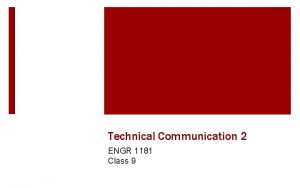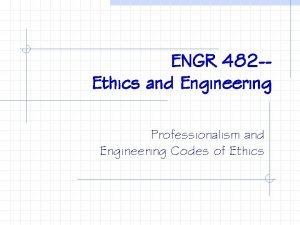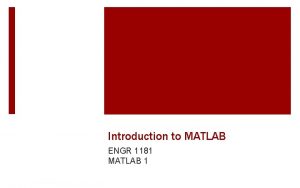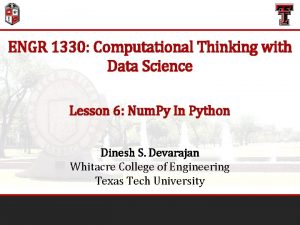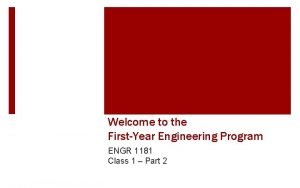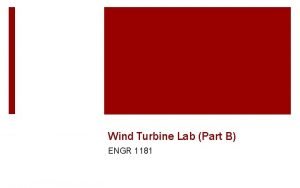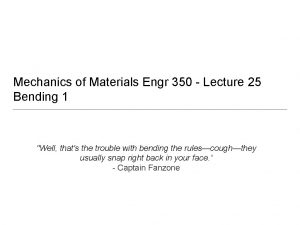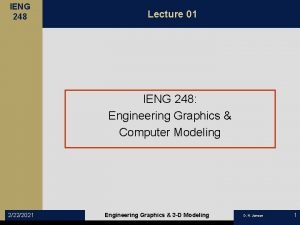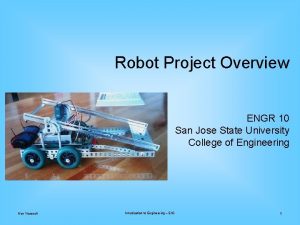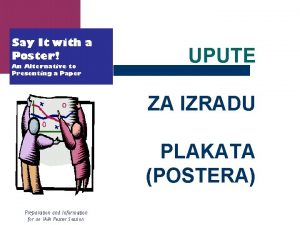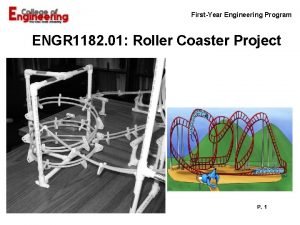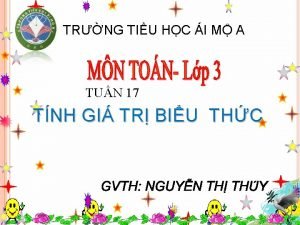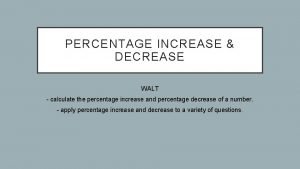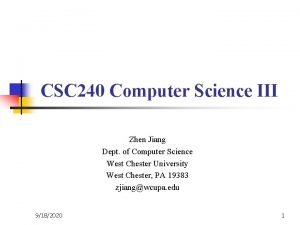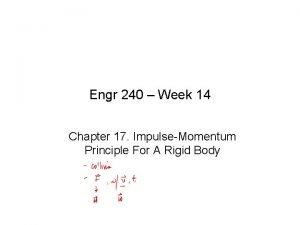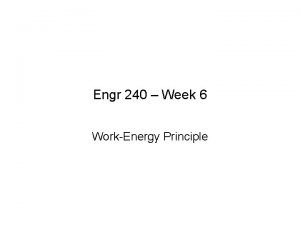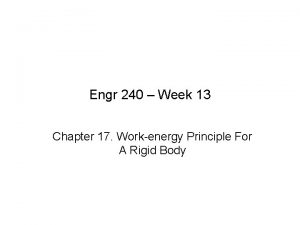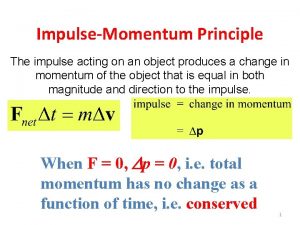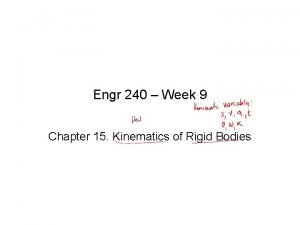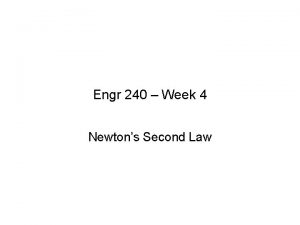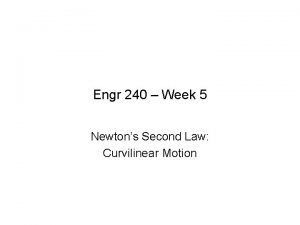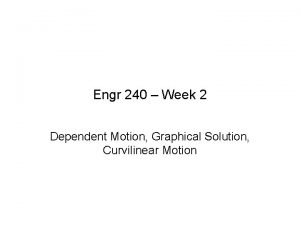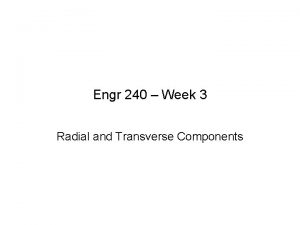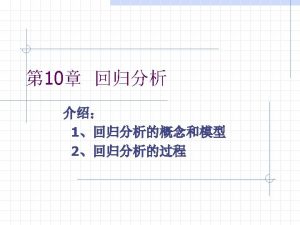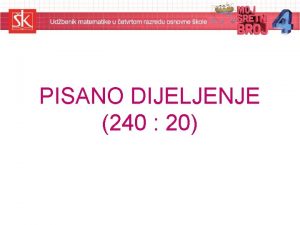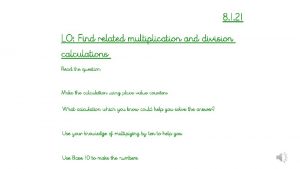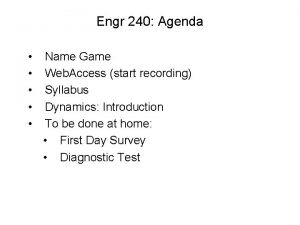Engr 240 Week 7 ImpulseMomentum Principle Principle of





















- Slides: 21

Engr 240 – Week 7 Impulse-Momentum Principle

Principle of Impulse and Momentum Derivation: • final momentum = initial momentum plus impulse of the force during the time interval.

Linear Impulse (or simply Impulse) Components are equal to the areas under the curves of Fx, Fy and Fz vs. t. Dimensions of the impulse of a force are force*time. Units for the impulse of a force are

Impulse-Momentum Principle Impulse-Momentum Diagram - Graphical Representation of I-M Principle • Has three component equations: x, y and z • With more than one force acting on a single particle: • With two or more particles: • If there is no net external force: Total linear momentum is conserved.

Example 1. The initial velocity of the block in position A is 30 ft/s. Knowing that the coefficient of kinetic friction between the block and the plane is k=0. 3, determine the time it takes for the block to stop.

Impulsive Motion • Impulsive force - Force acting on a particle during a very short time interval that is large enough to cause a significant change in momentum. • When impulsive forces act on a particle, neglect nonimpulsive forces: • When a baseball is struck by a bat, contact occurs over a short time interval but force is large enough to change sense of ball motion. • Nonimpulsive forces are forces for which FΔt is small and therefore, may be neglected.

Example 2. A 4 oz baseball is pitched with a velocity of 80 ft/s. After the ball is hit by the bat, it has a velocity of 120 ft/s in the direction shown. If the bat and ball are in contact for 0. 015 s, determine the average impulsive force exerted on the ball during the impact.

Example 3. A 10 kg package drops from a chute into a 25 kg cart with a velocity of 3 m/s. Knowing that the cart is initially at rest and can roll freely, determine (a) the final velocity of the cart, (b) the impulse exerted by the cart on the package, and (c) the fraction of the initial energy lost in the impact.


Impact • Impact: Collision between two bodies that occurs during a small time interval and involves large (impulsive) forces. • Line of Impact: Common normal to the surfaces in contact during impact. Direct Central Impact • Central Impact: the mass centers of the two bodies lie on the line of impact; otherwise, it is an eccentric impact. • Direct Central Impact: the velocities of the two bodies are directed along the line of impact. Oblique Central Impact • Oblique Central Impact: Impact for which one or both of the bodies move along a line other than the line of impact.

Direct Central Impact • Bodies moving in the same straight line, v. A > v. B. • Upon impact the bodies undergo a period of deformation, at the end of which, they are in contact and moving at a common velocity. • A period of restitution follows during which the bodies either regain their original shape or remain permanently deformed. • Wish to determine the final velocities of the two bodies. The total momentum of the two body system is preserved, • A second relation between the final velocities is required.

Direct Central Impact • Period of deformation: • Period of restitution: • A similar analysis of particle B yields • Combining the relations leads to the second relation between the final velocities.

Special Cases: 1. Perfectly plastic impact, e = 0: 2. Perfectly elastic impact, e = 1: • Total energy and total momentum conserved.

Oblique Central Impact • Final velocities are unknown (four unknown components). Four equations are required. • Conservation of momentum along tangential direction for each particle. (2 equations) • Conservation of total momentum in normal direction for both combined. (Impulsive force is internal. ) • Definition of coefficient of restitution applied in the normal direction.

Example 4 The magnitude and direction of the velocities of two identical frictionless balls before they strike each other are as shown. Assuming e = 0. 9, determine the magnitude and direction of the velocity of each ball after the impact. • Conservation of momentum along tangential direction each ball.

• Conservation of total momentum (for two balls combined) along normal. • Definition of coefficient of restitution along normal. • Solve last two equations simultaneously.

Summary of Results: n t

Constrained Oblique Central Impact • Block constrained to move along horizontal surface. • Impulses from internal forces along the n axis and from external force exerted by horizontal surface and directed along the vertical to the surface. • Final velocity of ball unknown in direction and magnitude and unknown final block velocity magnitude. Three equations required.

Constrained Oblique Central Impact • Tangential momentum of ball is conserved. • Total horizontal momentum of block and ball is conserved. • Normal component of relative velocities of block and ball are related by coefficient of restitution. • Note: Validity of last expression does not follow from previous relation for the coefficient of restitution. A similar but separate derivation is required.

Problems Involving Energy and Momentum • Three methods for the analysis of kinetics problems: - Direct application of Newton’s second law - Method of work and energy - Method of impulse and momentum • Select the method best suited for the problem or part of a problem under consideration.

 Engr 240
Engr 240 Week by week plans for documenting children's development
Week by week plans for documenting children's development Engr 201
Engr 201 Engr 1181
Engr 1181 Tamu engr 482
Tamu engr 482 Engr 10 sjsu
Engr 10 sjsu Engr 1182
Engr 1182 Engr 1181
Engr 1181 Engr 1330
Engr 1330 Engineering 1181
Engineering 1181 Engr 1181
Engr 1181 Mechanics of materials
Mechanics of materials Engr 248
Engr 248 Engr 1330 ttu
Engr 1330 ttu Sjsu engineering 10
Sjsu engineering 10 Engr 301 unr
Engr 301 unr Issdcm
Issdcm Performance task: roller coaster design
Performance task: roller coaster design Engr 112
Engr 112 Có 240 quyển sách xếp đều vào 2 tủ
Có 240 quyển sách xếp đều vào 2 tủ Percentage decrease
Percentage decrease Csc(240)
Csc(240)
